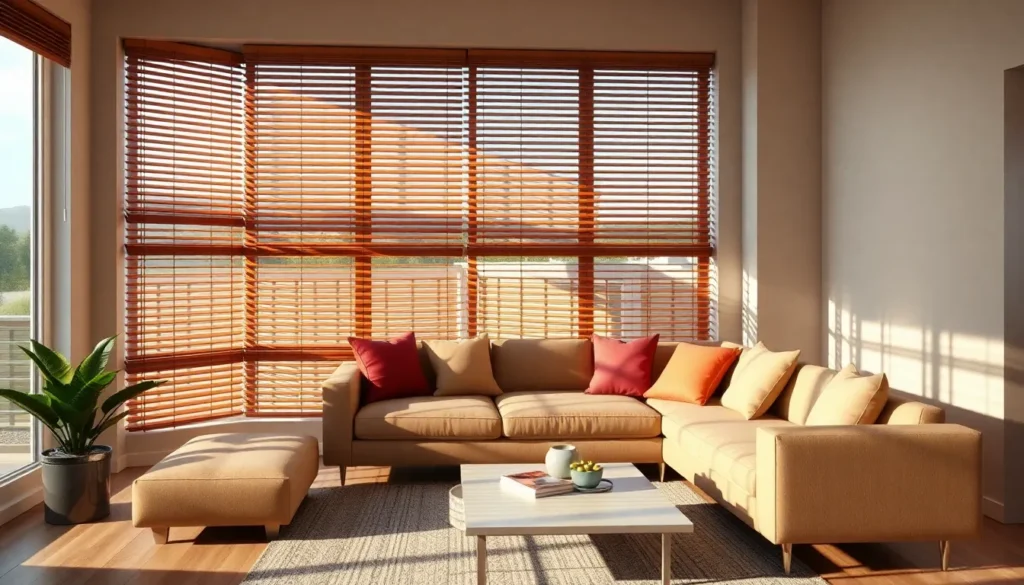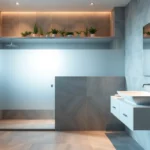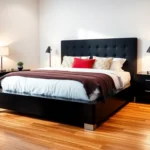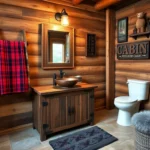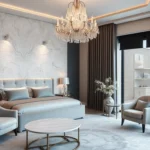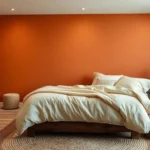Your living room deserves window treatments that combine style functionality and privacy seamlessly. Blinds offer the perfect solution to transform your space while giving you complete control over natural light and ambiance throughout the day.
We’ve discovered that choosing the right blinds can dramatically impact your living room’s aesthetic appeal and overall comfort. From sleek modern options that complement contemporary décor to classic designs that enhance traditional spaces blinds provide endless possibilities for customization. They’re also incredibly practical – you’ll love how easy it’s to adjust lighting for movie nights entertaining guests or simply relaxing with a good book.
Whether you’re working with large picture windows cozy corner spaces or unique architectural features we’ll explore creative blind ideas that’ll elevate your living room’s design. The right blinds don’t just cover windows – they become integral design elements that enhance your home’s personality while delivering the privacy and light control you need.
Choose the Right Blind Style for Your Living Room Layout
Your living room’s layout directly influences which blind styles will work best. We’ll guide you through matching blinds to your exact space configuration for optimal functionality and visual appeal.
Consider Room Size and Window Placement
Small living rooms benefit from vertical blinds that draw the eye upward and create an illusion of height. These blinds work exceptionally well on sliding patio doors or floor-to-ceiling windows. Horizontal blinds in light colors can make compact spaces feel more open by reflecting natural light throughout the room.
Large living rooms offer flexibility for bolder blind choices like wide-slat wood blinds or layered treatments. Roman shades paired with sheer panels create depth and visual interest in spacious areas. Corner windows require custom-fitted blinds that accommodate unusual angles without blocking architectural features.
Window placement determines your blind operation style preferences. High windows work best with cordless or motorized options that eliminate daily reaching. Multiple windows on the same wall should feature matching blind styles to maintain visual continuity and avoid a cluttered appearance.
Match Blinds to Your Furniture Arrangement
Sectional sofas positioned against windows require blinds that won’t interfere with seating comfort. Inside-mount blinds sit flush within the window frame and prevent fabric from catching on blind slats. Outside-mount options work better when furniture sits several inches away from the wall.
Coffee tables and side tables near windows need clearance consideration for blind operation. Top-down bottom-up blinds allow you to maintain privacy while keeping the upper portion open for natural light. This style prevents blind cords from tangling with decorative items or table lamps.
Entertainment centers and TV walls benefit from blackout blinds that reduce screen glare. Cellular shades provide excellent light control for movie watching while maintaining the room’s acoustic properties. Avoid glossy blind materials that create unwanted reflections on television screens.
Account for Natural Light Flow
South-facing windows receive intense sunlight throughout the day and require blinds with superior UV protection. Solar shades filter harmful rays while preserving outdoor views and preventing furniture fading. Light-filtering cellular shades diffuse harsh sunlight into gentle ambient lighting.
North-facing windows offer consistent but limited natural light that benefits from sheer or light-filtering blind materials. These options maximize available daylight without overwhelming the space. Avoid heavy or dark-colored blinds that further reduce natural illumination in these areas.
East and west-facing windows experience dramatic light changes that demand adjustable blind answers. Motorized blinds with timer settings automatically adapt to sunrise and sunset patterns. Dual-function blinds with both privacy and light-filtering capabilities handle morning glare and evening privacy needs effectively.
Select Materials That Complement Your Decor Theme
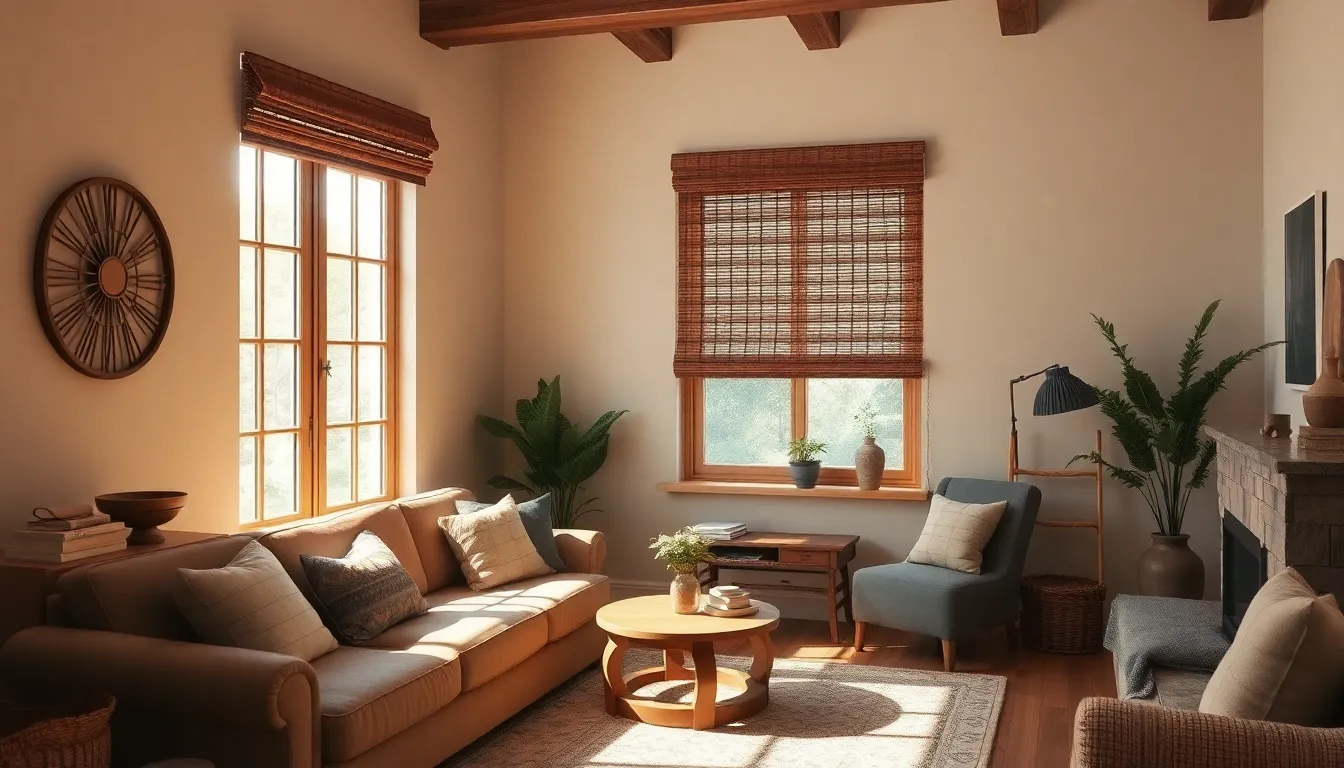
Choosing the right blind material creates harmony between your window treatments and existing decor style. We’ll explore three popular materials that serve different aesthetic preferences and practical needs.
Wood Blinds for Rustic and Traditional Spaces
Wood blinds bring natural warmth and authenticity to rustic and traditional living rooms. You can stain or paint these blinds to match your window trim, furniture pieces, and existing decor elements seamlessly. Natural wood grains enhance the room’s character while providing an eco-friendly window treatment option with a high-end feel.
Traditional spaces benefit from the classic appeal of wood blinds, which complement antique furniture and warm color palettes beautifully. Rustic settings gain texture and organic elements through wood’s natural variations and rich tones. These blinds age gracefully, developing character over time that adds to their charm.
Faux Wood for Budget-Friendly Durability
Faux wood blinds deliver the wood aesthetic at a fraction of the cost using polymer materials. These blinds resist chipping and fading better than natural wood while requiring minimal maintenance. We recommend faux wood for spaces with high moisture levels or humidity concerns, as they won’t warp or crack.
Budget-conscious homeowners appreciate how faux wood blinds provide premium appearance without premium pricing. Cleaning becomes effortless with these blinds since they handle moisture exposure and dust accumulation exceptionally well. Durability makes them ideal for busy living rooms where window treatments face daily use.
Aluminum for Modern and Minimalist Looks
Aluminum blinds create sleek, contemporary aesthetics perfect for minimalist and modern living spaces. Their lightweight construction makes installation and daily operation effortless while maintaining clean lines. We find aluminum blinds particularly effective in spaces featuring metal accents, glass furniture, or industrial design elements.
Modern living rooms benefit from aluminum’s crisp appearance and precise light control capabilities. Minimalist spaces appreciate the uncluttered look aluminum blinds provide without competing with other design elements. Maintenance stays simple with these blinds, requiring only occasional dusting to maintain their polished appearance.
Coordinate Colors to Enhance Your Living Room Palette
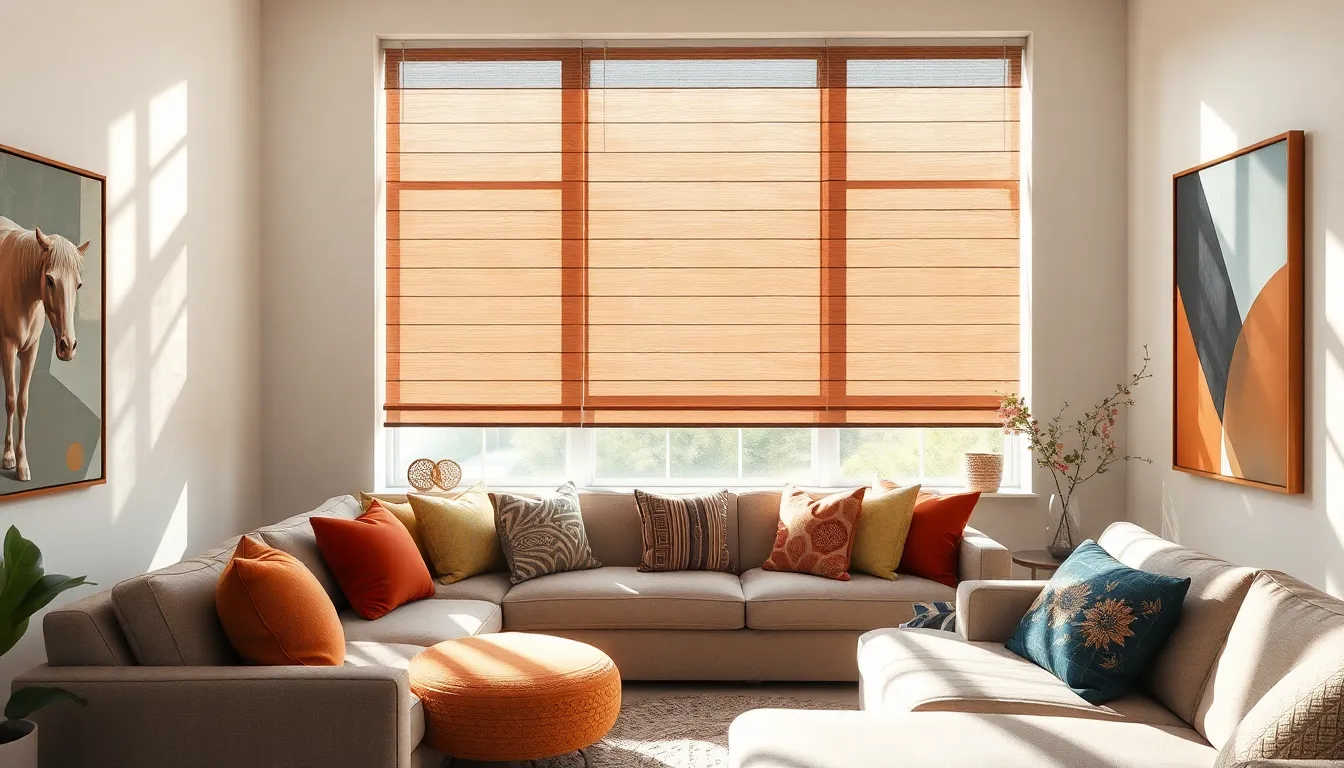
Color coordination transforms ordinary blinds into design elements that elevate your entire living space. We’ll explore three strategic approaches to create the perfect harmony between your window treatments and existing decor.
Neutral Tones for Versatile Design Flexibility
Neutral colored blinds serve as the foundation for adaptable living room design. Light fabric blinds protect privacy while allowing sunlight to filter through, making them ideal for spaces that need both illumination and seclusion. These versatile shades work seamlessly with seasonal decor changes and furniture updates without requiring window treatment replacements.
Roller blinds in neutral tones offer minimalist appeal that complements various room styles. Beige, cream, and soft gray options provide the perfect backdrop for colorful accessories and artwork. Vertical blinds in neutral shades create clean lines that won’t compete with your furniture or wall colors.
We recommend choosing neutral blinds when you frequently rearrange furniture or change accent colors throughout the year. These timeless options ensure your window treatments remain relevant regardless of design trends or seasonal updates.
Bold Colors for Statement-Making Windows
Bold colored blinds transform windows into focal points that command attention. Roman shades in vivid colors add dramatic pops of color while creating classic elegance in traditional living rooms. Deep blues, rich burgundies, and emerald greens work particularly well for creating sophisticated statement windows.
We suggest using bold patterned fabrics to make windows feature elements in otherwise neutral rooms. These eye-catching treatments draw the gaze upward and create visual interest without overwhelming the space. Bold colors work best when they complement at least one other element in the room, such as throw pillows or artwork.
Consider the room’s natural light exposure when selecting bold colors. South-facing windows can handle deeper shades, while north-facing spaces benefit from brighter, more vibrant options that enhance available light.
Pattern Options for Added Visual Interest
Patterned blinds introduce texture and movement to living room windows. Cellular shades feature honeycomb patterns that offer both visual appeal and energy efficiency through their insulated design. These structured patterns add subtle interest without overwhelming minimalist or contemporary spaces.
Layered treatments combining patterned blinds with solid curtains create elegant, sophisticated appearances. This approach allows you to incorporate multiple patterns while maintaining visual balance. Geometric patterns work well in modern spaces, while floral or botanical designs enhance traditional or cottage-style rooms.
We recommend matching fabric patterns from blinds to other textiles in your living room, such as throw pillows or upholstery accents. This coordination creates cohesive design flow while preventing pattern conflicts that can make spaces feel chaotic or overwhelming.
Layer Blinds With Curtains for Maximum Style Impact
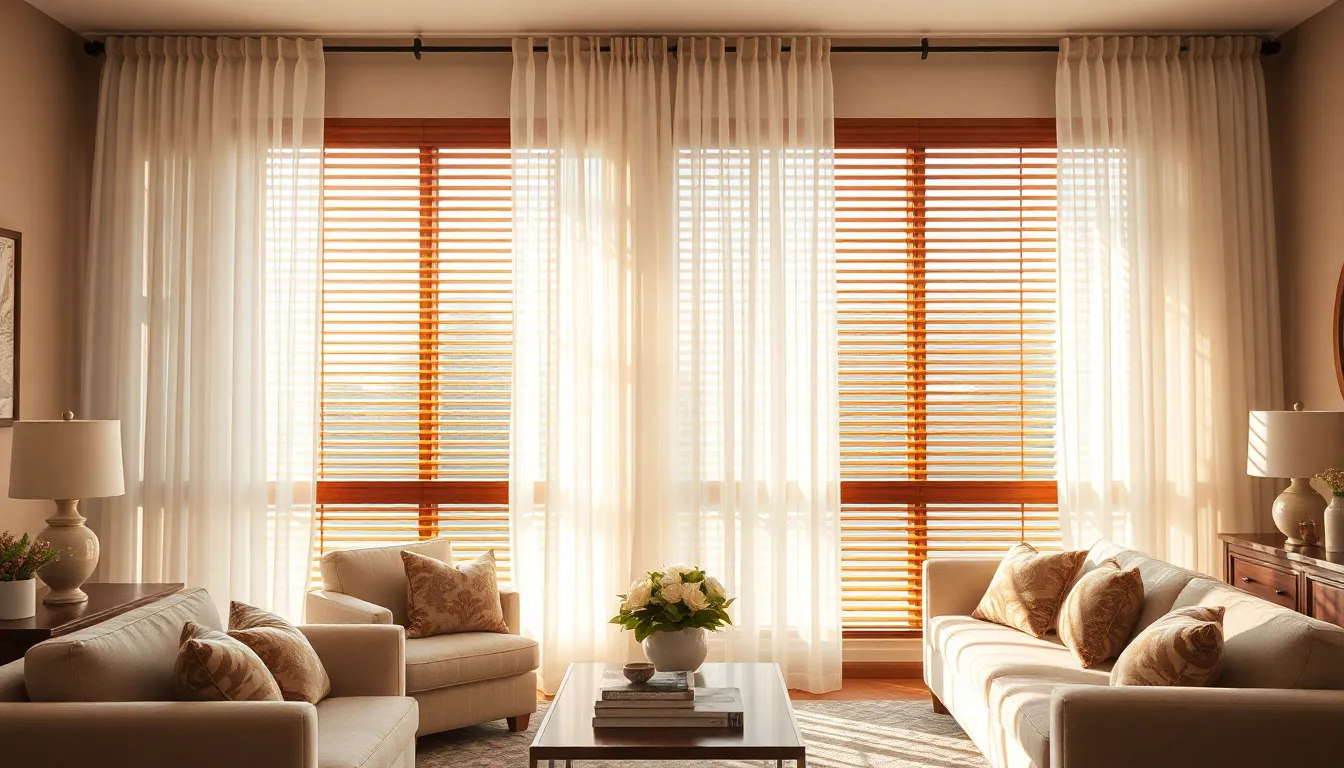
Combining blinds with curtains transforms your living room windows into sophisticated design features that offer both practicality and visual appeal. We recommend this versatile approach because blinds provide precise light control while curtains add softness and texture to your space.
Sheer Curtains Over Blinds for Soft Lighting
Sheer curtains layered over blinds create filtered light that enhances your living room’s ambiance without sacrificing privacy. We find this combination particularly effective for rooms where you want natural light to flow gently throughout the day.
Pairing Roman shades with sheer curtains delivers classic elegance while admitting maximum natural light into your space. The sheer fabric diffuses harsh sunlight and creates a warm, inviting atmosphere that’s perfect for entertaining or relaxing.
Installing curtain rods slightly above your blinds allows the sheer panels to hang freely and creates visual height in your room. We suggest choosing sheers in neutral tones like white, cream, or soft gray to complement your existing blinds and maintain a cohesive look.
Heavy Drapes Combined With Blinds for Privacy
Heavy drapes paired with blinds provide maximum privacy and superior light control for your living room. We recommend this combination for spaces that require complete darkness for movie nights or early morning sleep ins.
Blackout shades combined with thick curtains offer excellent insulation benefits and important noise reduction capabilities. This dual layer approach helps maintain comfortable temperatures year round while blocking unwanted sounds from busy streets or neighborhoods.
Selecting drapes in rich fabrics like velvet or heavy cotton creates a luxurious appearance while the blinds handle the functional aspects of light management. We suggest coordinating the curtain hardware with your blind finishes to create a polished, intentional design.
Valances to Frame Your Window Treatments
Valances serve as decorative crowns that frame your blinds and curtains while adding architectural interest to your windows. We use these finishing touches to create cohesive looks that tie your window treatments together with your room’s overall design scheme.
Matching valances to your curtain fabric or blind color creates visual continuity that makes your windows appear larger and more impressive. The valance acts as a bridge between your window treatments and ceiling, drawing the eye upward and improving your room’s proportions.
Wooden valances work particularly well with wooden blinds, while fabric valances complement curtain combinations beautifully. We recommend measuring carefully to ensure your valance extends beyond the blind width for proper framing and visual balance.
Install Smart Blinds for Modern Convenience
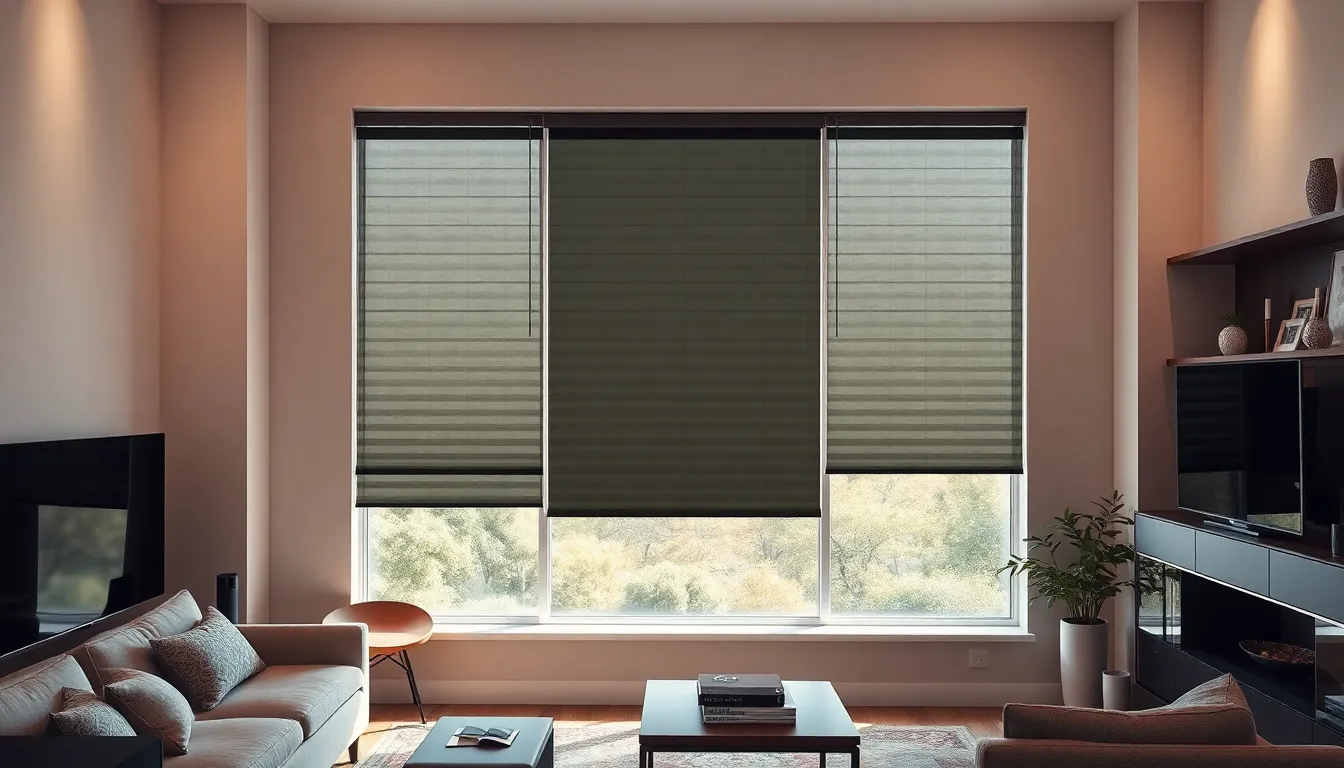
Smart blinds represent the next evolution in window treatments, combining sleek design with cutting-edge technology. Leading brands like Serena by Lutron, SmartWings, and IKEA offer custom-fitted answers that integrate seamlessly into any living room aesthetic.
Motorized Options for Easy Operation
Motorized blinds eliminate the hassle of manual adjustments while preserving your window treatments’ appearance. These systems reduce fabric wear by operating with consistent, gentle movements that traditional pull cords can’t match. We love how motorization enables automated scheduling features that open blinds at sunrise and close them at sunset.
Energy efficiency becomes effortless when your blinds respond to changing light conditions throughout the day. The automated operation means you’ll never forget to adjust them for optimal temperature control. Custom programming options let you create exact schedules for weekdays versus weekends, adapting to your lifestyle patterns.
App-Controlled Systems for Remote Access
Smartphone apps transform your living room blinds into remotely accessible window treatments. These dedicated applications offer position control that lets you adjust each blind to precise angles for perfect light filtering. Scene settings allow you to save favorite configurations like “movie night” or “morning coffee” for instant activation.
Group programming capabilities enable simultaneous control of multiple blinds throughout your home. We find this particularly useful when leaving for vacation or preparing for guests. The ability to adjust blinds from anywhere means you can maintain privacy and manage natural light even when you’re not home.
Position monitoring features show you the exact status of each blind through your phone. Many apps include scheduling functions that work independently of your home’s WiFi connection for reliable operation.
Voice-Activated Integration With Smart Homes
Voice commands through Amazon Alexa, Google Assistant, and Apple HomeKit provide hands-free blind operation. These integrations support home automation routines that can include lighting, temperature, and security systems alongside your window treatments. Simple phrases like “close the living room blinds” or “set blinds to 50 percent” make daily adjustments effortless.
Smart home compatibility means your blinds can respond to other connected devices in your network. Morning routines might gradually open blinds while starting your coffee maker and adjusting the thermostat. Evening automation can close blinds, dim lights, and activate security systems with a single voice command.
The integration supports complex scenarios where blinds adjust based on outdoor temperature, time of day, or even your calendar appointments. We appreciate how these systems learn from your preferences to suggest optimal blind positions for different activities and weather conditions.
Position Blinds Strategically for Privacy and Light Control
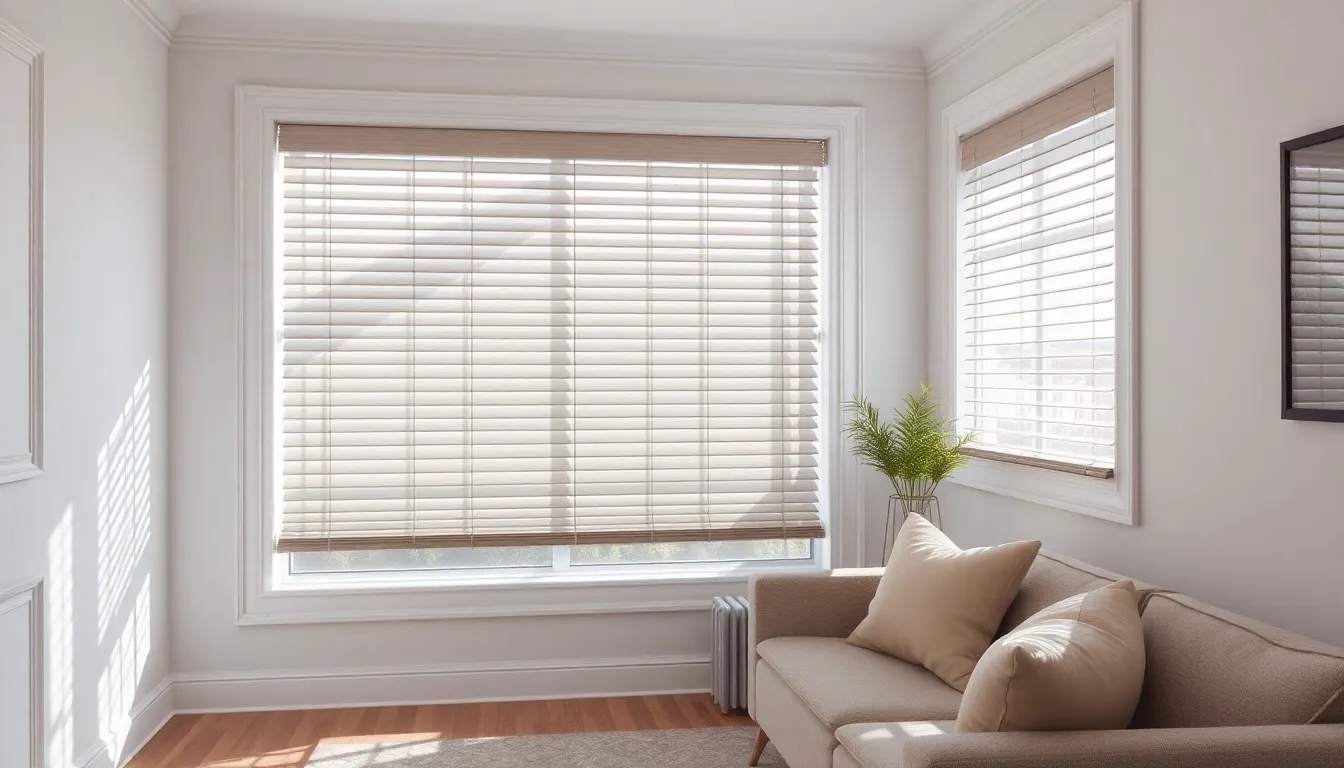
Strategic blind placement transforms how we control natural light and maintain privacy in our living spaces. We’ll explore three key positioning techniques that maximize both functionality and aesthetic appeal.
Inside Mount for Clean, Built-In Appearance
Inside mount installation creates a seamless, integrated look by fitting blinds directly within the window frame. We recommend this approach when you want to maintain clean architectural lines and showcase decorative window trim. This mounting style works particularly well with modern and minimalist living room designs where visual clutter needs to stay minimal.
Recessed blinds offer the advantage of staying completely out of the room’s visual field when raised. We find this especially beneficial in smaller living rooms where every inch of wall space matters for furniture placement and decor. The built-in appearance also protects blind mechanisms from accidental damage and creates a more streamlined window treatment solution.
Outside Mount for Maximum Light Blocking
Outside mount installation covers the entire window area and extends beyond the frame for superior light control. We use this technique when complete darkness is essential, such as in living rooms that double as home theaters or media spaces. The extended coverage eliminates light gaps that commonly occur with inside mount installations.
This mounting approach also solves common window frame issues like uneven surfaces or obstructions that prevent proper inside mount fitting. We particularly recommend outside mounting for rooms with challenging window configurations or when maximum energy efficiency is a priority. The broader coverage area significantly reduces heat transfer and light leakage around window edges.
Adjust Slat Angles for Optimal Privacy Balance
Slat angle adjustment gives us precise control over the balance between natural light and privacy throughout the day. We can tilt slats upward to direct light toward the ceiling while maintaining privacy from street level, or angle them downward to block harsh afternoon sun while preserving outdoor views.
Strategic angle positioning becomes particularly important during different daily activities in our living rooms. We adjust slats to steep angles during morning coffee routines for privacy, then open them to moderate angles for afternoon reading sessions that require gentle, diffused lighting. Evening adjustments can create ambient lighting effects while ensuring complete privacy from outdoor observers.
The key lies in experimenting with various angles throughout different times of day to find optimal positions for exact activities. We recommend marking preferred positions with small tape indicators on the control mechanism for quick, consistent adjustments.
Maintain Your Living Room Blinds for Long-Lasting Beauty

We’ve selected the perfect blinds for our living room, but proper maintenance ensures they’ll continue looking beautiful for years to come. Maintaining living room blinds properly extends their lifespan while preserving their aesthetic appeal and functionality.
Regular Cleaning Schedules by Material Type
Fabric blinds require weekly gentle dusting or vacuuming to prevent dirt from embedding into the fibers. We recommend using the upholstery attachment on your vacuum cleaner for best results. Spot cleaning with a mild detergent solution tackles stubborn stains without damaging the material.
Wood blinds need regular dusting with a microfiber cloth to maintain their natural beauty. We should wipe them down with a slightly damp cloth every two weeks, but avoid excessive moisture that could cause warping or cracking. Moving from top to bottom ensures we don’t redistribute dust onto already cleaned slats.
Faux wood blinds demand similar care with regular dusting and occasional wiping using a damp cloth. We must avoid harsh chemicals that could damage the synthetic finish or cause discoloration. These materials typically handle moisture better than real wood but still require gentle cleaning methods.
| Material Type | Frequency | Cleaning Method | Special Considerations |
|---|---|---|---|
| Fabric | Weekly | Vacuum/dust, spot clean | Use mild detergent solution |
| Wood | Bi-weekly | Microfiber cloth, damp wipe | Avoid excessive moisture |
| Faux Wood | Bi-weekly | Dust, damp cloth | No harsh chemicals |
Professional Maintenance for Complex Systems
Complex blind systems with intricate mechanisms benefit from professional cleaning services annually. We should consider hiring experts for hard to reach windows or when dealing with expensive materials like custom fabric or genuine wood blinds. Professional services provide deep cleaning that removes embedded dirt and allergens we might miss during regular maintenance.
Motorized blinds require specialized attention for their mechanical components beyond basic slat cleaning. We need professionals to inspect the motors, battery systems, and electronic controls to ensure optimal performance. Scheduling professional maintenance prevents costly repairs and extends the life of smart blind systems.
Seasonal Adjustments for Weather Protection
Summer months call for adjusting our blinds to block direct sunlight and reduce heat gain throughout the day. We should close slats during peak sun hours to protect furniture from UV damage while maintaining some natural light. Regular cleaning during summer prevents dust buildup from increased air conditioning use.
Winter adjustments focus on using our blinds for insulation by choosing thicker materials that reduce heat loss. We can open blinds during sunny winter days to capture natural heating and close them at night for better insulation. Positioning slats to allow maximum sunlight entry helps warm our living space naturally.
Spring and fall transitions require us to balance sunlight and temperature control as weather patterns change. We should adjust blind angles throughout these seasons to optimize comfort while maintaining energy efficiency. Cleaning schedules may need adjustment during these seasons due to changing pollen levels and dust patterns.
Additional maintenance tips include regularly inspecting cords and mechanisms for signs of wear that could affect operation. We should place doormats near windows to reduce the amount of dust entering our living space and settling on blinds.
Conclusion
We’ve explored the many ways blinds can transform your living room from functional window coverings to standout design elements. The right choice depends on balancing your style preferences with practical needs like light control and privacy.
Remember that investing in quality blinds and proper maintenance will ensure they continue improving your space for years to come. Whether you opt for smart technology or classic materials your blinds should reflect your lifestyle and complement your home’s overall aesthetic.
Take time to consider all the factors we’ve discussed and don’t hesitate to experiment with different combinations until you find the perfect solution for your living room.
Frequently Asked Questions
What are the main benefits of choosing blinds for my living room?
Blinds offer excellent light control, privacy, and style enhancement for your living room. They allow you to adjust natural light for different activities like reading or movie nights, while providing necessary privacy. Additionally, blinds serve as key design elements that can complement your decor and reflect your home’s personality.
How do I choose the right blind style for my living room size?
For small living rooms, vertical blinds create an illusion of height and make the space appear larger. Larger rooms can accommodate bolder choices like wide-slat wood blinds or layered treatments. Consider your window placement and furniture arrangement to ensure the blinds enhance both functionality and aesthetics.
Which blind materials work best for different decor themes?
Wood blinds offer natural warmth and work well with traditional or rustic themes. Faux wood blinds provide similar aesthetics with better moisture resistance and affordability. Aluminum blinds suit modern, minimalist designs and offer excellent durability and light control for contemporary spaces.
How should I coordinate blind colors with my living room palette?
Neutral tones like white, beige, or gray offer versatile design flexibility and work with most color schemes. Bold colors can create statement windows that complement accent pieces. Patterned blinds add visual interest but should be balanced with simpler decor elements to avoid overwhelming the space.
Can I layer blinds with other window treatments?
Yes, layering creates maximum style impact. Pair sheer curtains over blinds for soft, diffused lighting. Heavy drapes with blinds provide enhanced privacy and light blocking. Roman shades with sheer curtains offer elegance, while valances can frame the entire window treatment for a polished look.
What are smart blinds and how do they work?
Smart blinds are motorized window treatments that can be controlled via smartphone apps, voice commands, or automated schedules. Brands like Serena by Lutron and IKEA offer systems that integrate with smart home platforms, allowing for precise light control, energy efficiency, and convenient hands-free operation throughout the day.
Should I choose inside mount or outside mount installation?
Inside mount installations provide a clean, built-in appearance that’s ideal for modern designs and smaller spaces. Outside mount installations offer maximum light blocking and energy efficiency, making them perfect for rooms that double as home theaters or when you need complete darkness.
How often should I clean my living room blinds?
Cleaning frequency depends on material type. Fabric blinds need weekly dusting, wood and faux wood blinds require bi-weekly maintenance, and complex motorized systems may need professional cleaning. Regular maintenance extends blind lifespan and maintains their aesthetic appeal in your living room.
How do I optimize blinds for different seasons?
For summer, adjust slats to block direct sunlight while allowing airflow, reducing cooling costs. In winter, open blinds during sunny days to capture natural heat, then close them at night for insulation. Seasonal adjustments help maintain comfort and energy efficiency year-round.
What’s the best way to balance privacy and natural light with blinds?
Experiment with different slat angles throughout the day. Tilt slats upward to direct light toward the ceiling while maintaining privacy, or angle them downward for ground-level privacy. Adjust based on your activities – wider openings for reading, closed for movie watching, and partial openings for general living.

